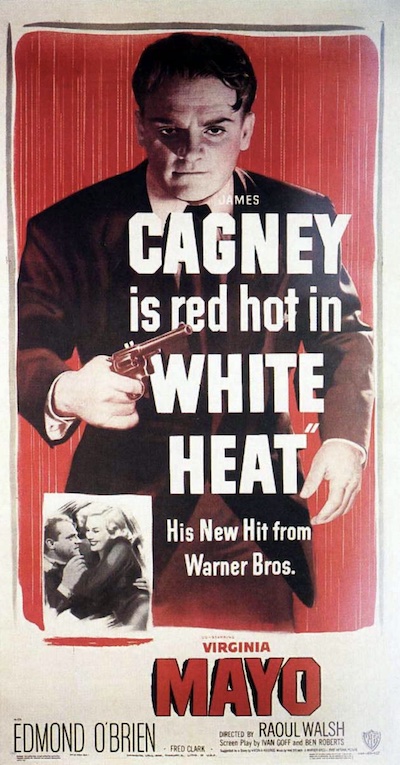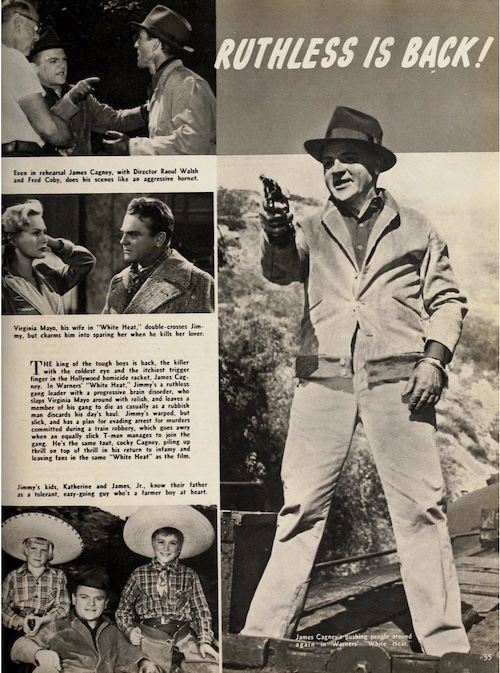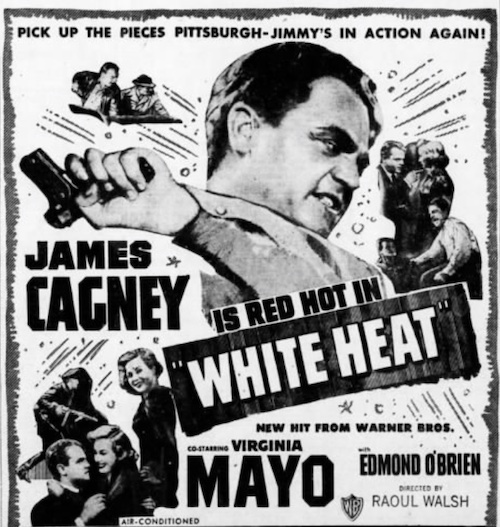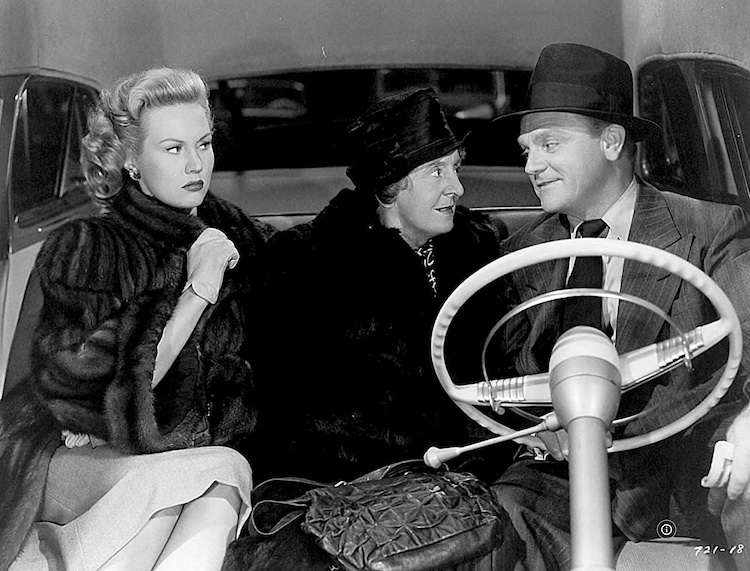Wednesday August 18, 2021
Movie Review: White Heat (1949)
WARNING: SPOILERS
In 2008, “White Heat” was voted the fourth-greatest gangster flick in Hollywood history by the American Film Institute, trailing only the first two “Godfather” movies and “Goodfellas,” and ahead of such classics as “Bonnie and Clyde,” “Pulp Fiction,” “The Public Enemy,” and both versions of “Scarface.” It’s the highest-ranked Cagney flick on IMDb, with an 8.1 rating, nudging out “Angels with Dirty Faces,” “One, Two, Three,” and “The Roaring Twenties,” all at 7.9. “Made it, Ma! Top of the world!” has been quoted, or misquoted, everywhere and forever. Ed “Kookie” Burns imitated Cagney saying it in a 1960 episode of “77 Sunset Strip,” Bart Simpson says it several times throughout the “Simpsons” run, while the MST3K group repeated it so often they began to parody it: “Top of the pantry, Ma!”; “Top of the Wrigley Building, Ma!” When AFI ranked its top 100 movie quotes, “Top of the world” landed at No. 18.
So guess who didn’t like “White Heat” much? James Cagney.
 In his 1974 memoir he calls it “another cheapjack job,” with a formulaic script “without a touch of imagination or originality,” and not much shooting time. He wanted his Irish Mafia pal Frank McHugh to play the role of Tommy Ryley, Warners said sure, then they said they couldn’t get him. “I found out later Frank had never been asked,” Cagney says.
In his 1974 memoir he calls it “another cheapjack job,” with a formulaic script “without a touch of imagination or originality,” and not much shooting time. He wanted his Irish Mafia pal Frank McHugh to play the role of Tommy Ryley, Warners said sure, then they said they couldn’t get him. “I found out later Frank had never been asked,” Cagney says.
The film also represented a defeat for him: his return to Warner Bros. and the despised Jack Warner—whom Cagney derided as the Shvontz, Yiddish for “prick”—after seven years of independent productions. During that time, Cagney and his brother Bill made four films. Two were gentle movies with literary pedigrees (“Johnny Come Lately” from the novel by Louis Brumfield, and “The Time of Your Life” from the Pulitzer Prize-winning play by William Saroyan); and two were johnny-come-lately actioners (“Blood on the Sun,” a WWII movie released as the war was ending, and “13 Rue Madeleine,” an O.S.S. homage released a year after “O.S.S.”). “Time of Your Life” turned out to be the real problem. It went overbudget and bombed at the box office, and, as Cagney biographer John McCabe writes, “the Cagneys badly needed, badly wanted a success. They both recognized White Heat as it.” Thus Warners. And thus the gangster role Cagney had forever been trying to put behind him.
If you read between the lines, Cagney mostly dismisses “White Heat” for the experience of making “White Heat” rather than for the movie itself. But that doesn’t mean the movie doesn’t have problems.
The original Waingro
Previous Cagney gangster flicks had been social-message movies about why men turn to crime: Tom Powers is corrupted by Putty Nose, Rocky Sullivan can’t run as fast as Jerry Connolly, Eddie Bartlett is a WWI “forgotten man.” None of that here. Here, it gets Freudian. The movie is based on a story by Virginia Kellogg, who based it on Ma Barker and her boys, with the four sons reduced to one. Apparently it was Cagney who suggested making Cody Jarrett psychotic; and it was Cagney who came up with the idea of sitting in Ma’s lap after she helps him through one of his debilitating headaches. The true shock of that scene is that it almost feels natural it’s acted so well.
They certainly don’t waste time getting to the Freudian: The opening shot is a train coming through a tunnel. They also don’t waste time giving us a classic Cagney line. During the train robbery, in front of the conductor, one of Cody’s men comments that the train’s burners are fancier than the ones he used on the C&O. That’s information—too much of it. Cody looks at the guy and says, “Shaddap!”
Four minutes in. I smiled.
A lot of the open is like the Waingro thing from Michael Mann’s “Heat.” Some guys just aren’t professional. The sloppy one here, Zuckie (Ford Rainey), not only says the above but calls Cody by name in front of the others. “Why don’t you give ’em my address, too?” Cody barks. Later, when the conductor says “You won’t get away with this, Cody,” Cody, after a glance at Zuckie, says, “You’ve got a good memory for names. Too good,” and shoots both him and his assistant in cold blood. Has a Cagney gangster ever shot a civilian before? An unarmed civilian? It’s the movie letting us know early on that this isn’t your father’s Cagney gangster.
 Zuckie winds up paying heavily for his loose lips—but from karma rather than Cody. When the assistant is killed, he falls on a lever that releases boiling steam right into Zuckie’s face. The man then has to hole up with the rest of the gang in a mountain cabin, in pain, face and hands bandaged, mummified. When they make a break for it, they have to leave him behind—he’s too conspicuous—but then Ma Jarrett (Margaret Wycherly) warns Cody about how talkative he is, so Cody sends back his pal Cotton (Wally Cassell) to put him out of his misery. Cotton can’t do it; he shoots in the air. He thinks he’s doing a good deed, but instead of dying quickly, Zuckie, already mummified, dies slowly and painfully of exposure. That’s a helluva lot of karma for one “Cody.”
Zuckie winds up paying heavily for his loose lips—but from karma rather than Cody. When the assistant is killed, he falls on a lever that releases boiling steam right into Zuckie’s face. The man then has to hole up with the rest of the gang in a mountain cabin, in pain, face and hands bandaged, mummified. When they make a break for it, they have to leave him behind—he’s too conspicuous—but then Ma Jarrett (Margaret Wycherly) warns Cody about how talkative he is, so Cody sends back his pal Cotton (Wally Cassell) to put him out of his misery. Cotton can’t do it; he shoots in the air. He thinks he’s doing a good deed, but instead of dying quickly, Zuckie, already mummified, dies slowly and painfully of exposure. That’s a helluva lot of karma for one “Cody.”
It’s at the mountain cabin that we see the movie’s early conflicts. Cody’s main rival for gang leadership is Big Ed (Steve Cochran), who is making eyes with Cody’s wife, Verna (Virginia Mayo), a lazy, complaining thing. If Cody knows there’s something between them he doesn’t care much. Maybe because he doesn’t care much for Verna? And maybe Verna senses this? She’s an opportunist, and while she’s with the No. 1 guy, she knows she’ll never be No. 1 in his heart. That spot is for Ma. So she takes his rival, too.
Big Ed has a slight Robert Mitchum thing going, but in a nice monologue Cody cuts him down to size:
You know something, Verna? If I turn my back long enough for Big Ed to put a hole in it, there’d be a hole in it. Big Ed. Great Big Ed. You know why they call him that? Because his ideas are big. Someday he's gonna get a really big one—about me. And it’ll be his last.
No one ever made “Big” sound so small.
It’s right after this speech that he gets a debilitating headache. That’s when Ma takes control. She pushes him into the bedroom, shuts the door, massages his head, talks him through it, then makes him wait before reappearing before the gang. He sits in her lap and they talk; then she gives him a shot of bourbon and tells him “Top of the world, son.” The later explanation for these headaches, which we get through Treasury Dept. officials, is that as a child he faked headaches to get Ma’s attention and now he gets them for real. To me, why he gets them is less important than what they mean for the story. They’re our pathway into knowing more about Cody and his mom; and they’re the pathway for undercover T-Man Hank Fallon (Edmond O’Brien) to get into his good graces.
Let’s talk about that second headache. By this time Cody is in prison in Springfield, Illinois, having pled guilty to a lesser crime that happened concurrently with the train robbery. Fallon is undercover as “Vic Pardo,” with an eye on Cody. He tries to break the ice in the courtroom, then in the prison yard, then in the prison machine shop where he saves Cody’s life. Nothing works. Cody doesn’t trust nobody he doesn’t know. It’s only after Ma visits Cody and warns him about Big Ed that he puts two and two together about the machine-shop “accident”; and it’s only after Cody gets the second headache, and Pardo talks him through it like Ma did, and massages his head like Ma did, that Cody decides to trust him. He even gives him the old Cagney cheek pat.
We don’t know it yet but a kind of transference has taken place. The visiting-room scene is the last time Cody (and we) will see of Ma—she’s shot in the back by Verna, off-screen—and who’s there to take her place? This smart kid, Pardo. For the rest of the movie, he’s the guy Cody trusts. At one point, Cody salutes him with Ma’s catchphrase, “Here’s to us: Top of the world,” and splits his share with him, 50-50, which he’d only done with Ma before. He’s the son he never had. Part of me wonders if the movie would’ve been more interesting if Ma hadn’t died, for then she would’ve had a true rival in Pardo, rather than the shallow rival Verna always represented.
That said, Ma’s death is when the movie roars to life.
The original Joker
Before then, Cody was always back on his heels. After the train robbery, he: 1) holes up in the cabin; 2) holes up in a motel; 3) holes up in prison. He’s forever biding his time. It gets a little dull. Then he hears about Ma. Now he’s relentless, gunning for Big Ed and Verna and forever on the move, eating a chicken drumstick with one hand while killing a guy in his car trunk with the other. Whoever came up with the drumstick, the nonchalance of it, is a genius. It’s one of the best scenes in a movie filled with great scenes. It’s “Goodfellas” 40 years before “Goodfellas.”
And then just as suddenly the air goes out of the movie again. Once he’s killed Big Ed (after Verna lies about who killed Ma), all the old conflicts are resolved: Ma’s dead, Big Ed’s dead, and Verna is muted. With a half hour left, it’s like the movie needs to regroup. The transition is almost comic. We go from Cody pushing Big Ed’s body down the stairs—“Catch,” he says to his men with that Cagney sneer, as the soundtrack music wells up—to a close-up of a ceramic tchotchke, a woman carrying a bowl, into which Cody is quietly tossing coffee beans. Tink. Tink. Tink. His men are gathered around a dining table with a new caper but they can’t get him interested. He’s like a kid, a motherless child, but it leaves the movie slightly adrift. What now?
 Well, three things. We get the new caper—a payroll heist of a chemical plant. The movie also introduces us to an operator above Cody, Winston, AKA “the Trader” (Fred Clark), whom Cody calls “my manager.” It’s an 11th-hour inclusion that feels a little lame, to be honest. Finally, and most important, we begin to get a sense of Cody not as some malicious unstoppable force, or a crazy mama’s boy, but as a regular guy. He takes Pardo into his confidence. He admits he walks around at night talking to his mother. “That sound funny to you?” he asks. “Some might think so.” He opens up about his dad in the nuthouse and how his mom always propped him up. The two men drink together with Verna, who gets excited about traveling to Paris. They feel like regular people here. You almost begin to feel sorry for Cody. The two closest people in his life are an undercover Fed and the woman who killed his beloved mother.
Well, three things. We get the new caper—a payroll heist of a chemical plant. The movie also introduces us to an operator above Cody, Winston, AKA “the Trader” (Fred Clark), whom Cody calls “my manager.” It’s an 11th-hour inclusion that feels a little lame, to be honest. Finally, and most important, we begin to get a sense of Cody not as some malicious unstoppable force, or a crazy mama’s boy, but as a regular guy. He takes Pardo into his confidence. He admits he walks around at night talking to his mother. “That sound funny to you?” he asks. “Some might think so.” He opens up about his dad in the nuthouse and how his mom always propped him up. The two men drink together with Verna, who gets excited about traveling to Paris. They feel like regular people here. You almost begin to feel sorry for Cody. The two closest people in his life are an undercover Fed and the woman who killed his beloved mother.
All of which raises the question: Just how nuts is Cody? Sure, he loses it in the prison mess hell, climbing over everything and blindly fighting everybody to get away from the mere knowledge of his mother’s death. Cagney, as a kid, once visited a friend’s uncle at a hospital for the insane on Ward’s Island. “My God, what an education that was!” he says in his memoir. “The shrieks, the screams of those people under restraint.” Those are the noises he’s making as he’s fighting the guards. And yet, in the next scene, Cody is totally lucid, plotting with Tommy Ryley (Robert Osterloh), and for the rest of the movie his mental state seems to improve. No headaches, for example. He loosens up. Pardo is good for him. He’s someone to take over, as Cody took over from Ma.
No, what really sends Cody over the edge is the great betrayal, when he finds out that Pardo is a copper, a lousy copper, and that he’s truly alone in the world. Cagney’s reaction shot to this is underrated—smiling through the pain and tears in his eyes. That’s when the giggle enters his voice. That’s when, giggling and fighting amid the industrial landscape, he seems like the first-onscreen version of the Joker. He even begins talking about himself in the third person, as if he’s narrating his own story:
They think they got Cody Jarrett. They haven’t got Cody Jarrett, you hear? They haven’t got him. And I’m going to show you how they haven’t got him.
Is this a first for a Cagney movie? This third-person talking? Either way, Ryley, the last man standing in his gang, sees where Cody is going (taking the stairs up and up to disaster, the mirror image of John Garfield taking the stairs down and down in “Force of Evil”), and he tries to surrender to the cops; but Cody, giggling, shoots him in the back. This is where Cagney’s wished-for casting really would’ve had an impact. That was supposed to be Frank McHugh. Imagine Cagney shooting his old Irish Mafia pal in the back. Wow.
And then another wow: the famous ending. Rather than surrender, Cody goes out in a blaze of glory, shouting the words Ma drummed into him. Did he get the irony of it? I think he did. Were the explosions supposed to remind 1949 audiences of the A-bomb? I think they were. Unfortunately, the movie doesn’t end there. The original story was just as much police procedural as gangster tale until writers Ivan Goff and Ben Roberts scaled the police part back—just not enough. The cops keep showing up: flat, institutional men talking oscillators and transmitter wavelengths and cross-plotting at a bearing of 210 degrees. It’s Dick Tracy decoder-ring stuff without the gee whiz. And the movie gives them the last word. It doesn’t go out on top, with No. 18 on the AFI list, but pans back to the T-Men watching it all in the flickering light of the fires Cody created:
Evans [dismissive]: Cody Jarrett.
Fallon: He finally got to the top of the world. And it blew right up in his face.
They’re the guys explaining the joke that everyone gets.
The original
Anyway, those are some of my problems with the film: our lead is back on his heels too much, the movie needs to regroup 30 minutes before the end, and the police procedural stuff is flat. Director Raoul Walsh films it flat, too, documentary style. Warners’ chinciness didn’t help.
It’s still a great movie. Howard Hawks once said that a good movie is three good scenes and no bad scenes, and while the police procedural is dull there are more than enough great scenes to make up for it. When Cagney’s on the screen, the movie is on. He’s also got a nice supporting cast. Virginia Mayo just pops; there’s not a false note there. I love her spitting out her gum before kissing Cody, or the way she attempts to ingratiate herself with the T-Men—an opportunist to the end. She also gets the Mae Clarke treatment: knocked off a chair rather than the grapefruit to the face. Cagney liked her so much he requested her for his next Warners movie, the musical “The West Point Story,” even though she had to learn to dance. Then there’s Margaret Wycherly, a British stage actress, who played Ma with a matter-of-fact maliciousness. She’s all business and task No. 1 is her boy. You get why Cody loves her.
“White Heat” is a good end to Cagney’s Warner Bros. gangster cycle, recalling the first, “Public Enemy,” more than the middle two, “Angels” and “Roaring Twenties,” where Cagney is essentially an orphan and nice guy. Here, as in “Enemy,” he’s got Ma and that sneer. “Ruthless is back!” the ads proclaimed, and it was, even if, at times, on quiet nights when it couldn’t sleep, it still wandered around talking to its mother.

The happy couple.
Baseball's Active Leaders, 2023
What Trump Said When About COVID
Recent Reviews
Everything Everywhere All at Once (2022)
Black Panther: Wakanda Forever (2022)
Doctor Strange in the Multiverse of Madness (2022)
Spider-Man: No Way Home (2021)
The Cagneys
A Midsummer Night's Dream (1935)
Something to Sing About (1937)
Angels with Dirty Faces (1938)
A Lion Is In the Streets (1953)
Man of a Thousand Faces (1957)
Never Steal Anything Small (1959)
Shake Hands With the Devil (1959)







